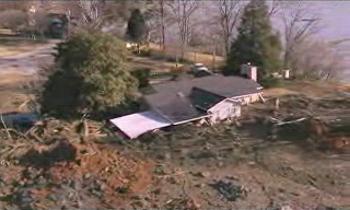Locations of High Hazard Coal Ash Waste Impoundments Made Public
WASHINGTON, DC, July 12, 2009 (ENS)
The U.S. Environmental Protection Agency has posted a list of 44 "high hazard potential" impoundments containing coal combustion residuals, commonly referred to as coal ash, at 26 different coal-burning electric utility facilities in 10 states.
The 10 states on the list are Arizona, Georgia, Ohio, Illinois, Indiana, Kentucky, Montana, North Carolina, Pennsylvania, and West Virginia.
On June 12, Senator Barbara Boxer, who chairs the Senate Environment Public Works Committee, revealed the existence of the "high hazard" list but said the EPA was forbidden to release this list on orders of the U.S. Army Corps of Engineers and the Department of Homeland Security.
On June 18, Earthjustice, the Sierra Club, the Environmental Integrity Project and the Natural Resources Defense Council filed a Freedom of Information Act request to make public the location of these sites after the EPA refused to do so.
On June 29, EPA released this information after interagency coordination with FEMA's Risk Analysis Division Mitigation Directorate and the U.S. Army Corps of Engineers.
"The presence of liquid coal ash impoundments near our homes, schools and business could pose a serious risk to life and property in the event of an impoundment rupture" said EPA Administrator Lisa Jackson. "By compiling a list of these facilities, EPA will be better able to identify and reduce potential risks by working with states and local emergency responders."
A high hazard potential rating is not related to the stability of those impoundments but to the potential for harm should the impoundment fail.
Senator Boxer commended the Obama administration for releasing the list of high hazard coal ash waste sites, but said she still intends to conduct committee hearings on the issue.
"I called on the administration to release the list of these high hazard sites so that people have the information they need to quickly press for action to make these sites safer," Boxer said. "The Environment and Public Works Committee will continue its investigation of these coal ash waste impoundments, and as part of our oversight, I plan to conduct additional hearings on this issue."
Earthjustice attorney Lisa Evans said, "We are pleased to see that our request was not ignored and are heartened by this decision. Coal ash dump sites contain harmful levels of arsenic, lead, mercury and other toxins that can contaminate drinking water sources or potentially flood surrounding communities, as happened last December in Tennessee."
 |
One of a dozen houses damaged in the TVA's Kingston coal ash spill (Photo courtesy TVA) |
Following the failure of an impoundment at the Tennessee Valley Authority facility in Kingston, Tennessee on December 22, 2008, the EPA has been gathering information on coal combustion residual impoundments from electrical utilities nationwide and conducting on-site evaluations to determine the impoundments' vulnerabilities.
More than 1.1 billion gallons of coal ash spilled at Kingston in the largest fly ash release in United States history. The sludgy mess covered up to 300 acres and the confluence of the Emory and Clinch rivers, damaging homes, roads and a section of railway.
As part of its response to the Kingston spill the EPA sent a letter dated March 9 to all coal-fired electric utilities requesting information about their coal ash impoundments.
The list of high hazard units was compiled from information submitted to EPA by the electric utilities in response to the EPA's request. Jackson pledged that the 44 units will receive high priority attention as EPA continues its assessment of impoundment safety.
Jackson announced in March that she will propose a regulation on the management of coal combustion wastes by December 31, 2009.
Evans said, "This administration is fulfilling its commitment to scientific integrity and open government, and we hope that additional information about the location, size and ownership of the hundreds of other toxic coal ash sites will be made equally available as soon as possible. We also hope the EPA continues on this path and proposes to finally regulate toxic coal ash and once and for all establish the protections that communities and nearby neighbors want, need and deserve."
Click here for the State-by-State List of "High Hazard" Coal Ash Waste Sites Released by EPA.
Copyright Environment News Service (ENS) 2009. All rights reserved.
To subscribe or visit go to: http://www.ens-newswire.com